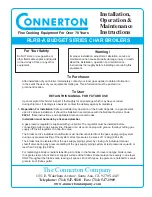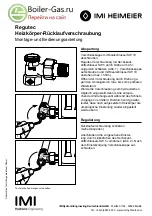
13.0
CHANGING COMPONENTS
13.10
PUMP - HEAD ONLY
1. Drain the primary circuit and disconnect the wiring
connector from the pump head.
2. Remove the four socket head screws securing the pump
head to the body and draw the head away (Fig. 62).
3. A replacement Grundfos 15-60 head can now be fitted
(Fig. 62)(Part No: 500672).
4. Reassemble in reverse order.
5. Replace the wiring connector into the socket on the pump
head.
36
© Dimplex Boilers 2008
13.11
HYDROBLOCK
1. Drain the primary circuit.
2. Remove the four stainless clips at the base of the hydro-
block and disconnect the four pipes (Fig. 63).
3. Un-lock the two locking clips on the flow and return ports.
4. Disconnect the discharge pipe from the pressure relief valve.
5. Remove the four securing screws from below the boiler.
6. Carefully remove the hydro-block and change the relevant
components.
7. Reassemble in reverse order taking care to replace all the
clips correctly. Ensure the locking clips are in the ‘Locked’
position as shown opposite.
Pump Head
Locking Clip
Front
Stainless Clips
Rear
Stainless Clips
Un-Locked
(viewed from pipe end)
Locked
(viewed from pipe end)
X 4
X 2
X 2
Fig. 62
Fig. 63
6.0
SYSTEM DETAILS
6.7
DOMESTIC HOT WATER CIRCUIT
1. All DHW circuits, connections, fittings, etc. should be fully in
accordance with relevant standards and water supply
regulations.
2. Further guidance is given in:
for GB: Guidance G17 to G24 and recommendation R17 to R24
of the Water Regulations Guide.
for IE: the current edition of I.S. 813 “Domestic Gas
Installations”.
3. When the domestic water system includes any device which
prevents water expanding back towards the supply (check
valve, loose jumpered stopcock, water meter, water treatment
device) then an expansion vessel must be fitted (e.g. Zilmet
160ml, R
1
/
2
15bar).
A single check valve must be fitted as shown in Fig. 10 to
prevent backflow to the supply pipe and to ensure the efficient
operation of the expansion vessel which is required to
accommodate the thermal expansion of the water.
If the hot water expansion is not provided for, then high
pressures can develop which may result in damage to fittings
and devices on the system.
4. The boiler’s maximum working mains pressure is 10 bar,
therefore all pipework, connections, fittings, etc. should be
suitable for pressure in excess of 10 bar. A pressure reducing
valve must be fitted for pressures in excess of 10 bar.
5. The final 600mm of the cold mains supply and domestic hot
water outlet must be made in 15mm copper pipe.
6. A cold mains flow regulator is fitted on the inlet to the flow
turbine (see Figs. 2 & 3 - page 8) to control water flow rates.
This may be removed to obtain higher flow rates. Flow rates
higher than specified for the appliance will reduce the
domestic hot water temperature.
© Dimplex Boilers 2008
13
6.8
SHOWERS
1. If a shower control is supplied from the appliance it should
be of the thermostatic or pressure balanced type. Thermostatic
type shower valves provide comfort and guard against high
water temperatures. Existing controls may not be suitable -
refer to the shower valve manufacturer.
6.9
HARD WATER AREAS
1. If the area of the installation is recognised as a HARD WATER
AREA then a suitable device should be fitted to treat the mains
water supply to the boiler. Contact your Water Distribution
Company for advice on suitable devices.
Expansion
Vessel
Boiler
Check
Valve
Stop Tap
Pressure
Reducer
Valve
To Hot
Taps
Other Tap
Outlets
Fig. 10
48pp MANUAL SPREADS 19/10/10 08:36 Page 13










































